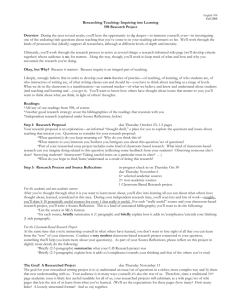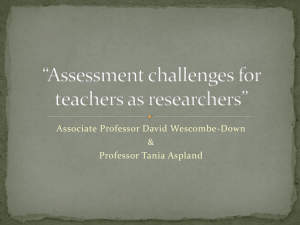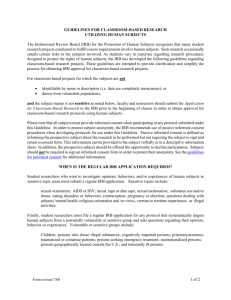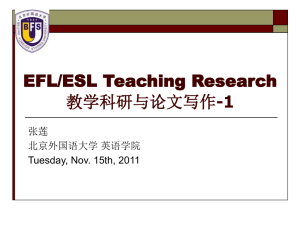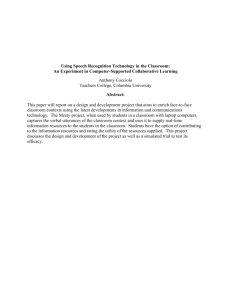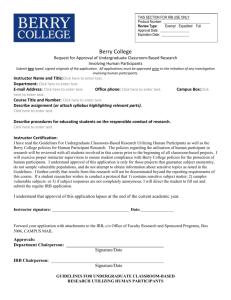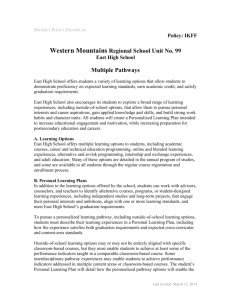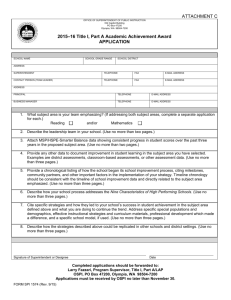- ePrints Soton
advertisement
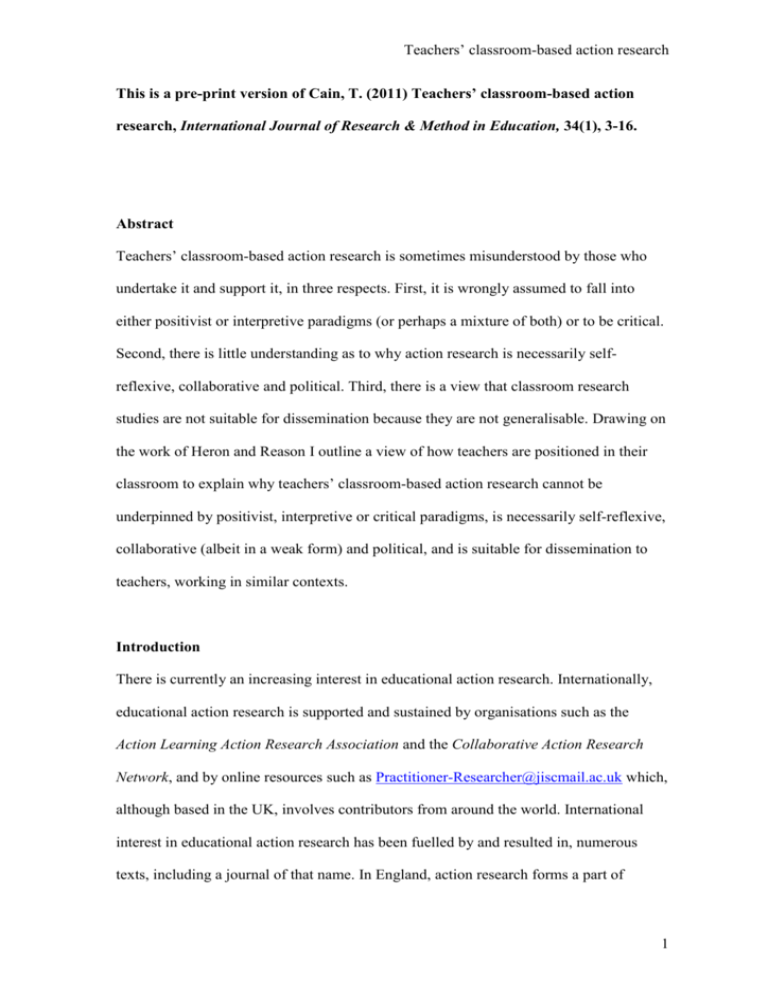
Teachers’ classroom-based action research This is a pre-print version of Cain, T. (2011) Teachers’ classroom-based action research, International Journal of Research & Method in Education, 34(1), 3-16. Abstract Teachers’ classroom-based action research is sometimes misunderstood by those who undertake it and support it, in three respects. First, it is wrongly assumed to fall into either positivist or interpretive paradigms (or perhaps a mixture of both) or to be critical. Second, there is little understanding as to why action research is necessarily selfreflexive, collaborative and political. Third, there is a view that classroom research studies are not suitable for dissemination because they are not generalisable. Drawing on the work of Heron and Reason I outline a view of how teachers are positioned in their classroom to explain why teachers’ classroom-based action research cannot be underpinned by positivist, interpretive or critical paradigms, is necessarily self-reflexive, collaborative (albeit in a weak form) and political, and is suitable for dissemination to teachers, working in similar contexts. Introduction There is currently an increasing interest in educational action research. Internationally, educational action research is supported and sustained by organisations such as the Action Learning Action Research Association and the Collaborative Action Research Network, and by online resources such as Practitioner-Researcher@jiscmail.ac.uk which, although based in the UK, involves contributors from around the world. International interest in educational action research has been fuelled by and resulted in, numerous texts, including a journal of that name. In England, action research forms a part of 1 Teachers’ classroom-based action research ‘Masters’ level’ pre-service education (Jackson 2009) and is also used as a means of assessing teachers on the Masters’ degree in Teaching and Learning (TDA 2009). Action research involves practitioners; thus the increasing interest in educational action research has potential to engage teachers in research, and to correct a still widespread view of research as irrelevant to teachers’ practice. However, all is not well. When teachers undertake action research as part of a higher degree, they can feel a pressure to work individually so that their research is entirely their own. They can be supported by university-based researchers, some of whom misunderstand the nature of teacher research. Indeed, Winter (1997) argues that universities have a ‘vested interest’ in promulgating what he calls the ‘spectator’ model of research because, ‘the university draws a particular form of cultural authority from its institutional separation from the motives of practical life’ (emphasis in the original). Hence, sometimes ‘the link with the university threatens to distort action research’ (not paginated). There are problems of quality in teacher research. Reviewing 25 teacher research studies Foster (1999) reported, ‘in nearly all the reports insufficient evidence is presented to support key claims’ (p. 388) including ‘unconvincing’ causal claims. Clayton and O’Brien et al. (2008) found that teachers’ research potential can sometimes be frustrated by ‘quantitative and essentially positivistic’ understandings of research (p. 78). Further, the website of the National Teacher Research Panel (2009) contains over one hundred publications on research informed practice, mostly by teachers and school managers. Several of the classroom-based studies use experimental designs with control groups (including Anderson 2009; Arthington 2009; Bartley 2009) mostly in an attempt to compare teaching strategies. As a result they rest on a misunderstanding of the nature of teachers’ action research and hence, generate questionable findings. 2 Teachers’ classroom-based action research In my own practice, I have read reports of inappropriate student teachers’ action research, even when I have taught the students. For example, I teach a short course called ‘self study’, in which student teachers are encouraged to adopt an action research process to investigate their own practice. Recently, one of my students asked me for advice. Focusing on the nature of respect, she had carried out two lessons: in one, she had shown the pupils a lot of respect, greeting them politely, listening attentively and showing care and consideration and, in the second, she had done none of these things, but had treated her students with disdain and a lack of consideration. She now planned to investigate her students’ responses to these lessons; her query was, ‘Is this ok?’ I suppose most teachers have times when they suffer agonies of frustration, wondering why what they have said has been so misunderstood; this was one of mine. Imagining the ‘lack of respect’ lesson, I cringed. This incident confirmed that teachers’ action research is not always well understood, and it reminded me that even enthusiasts like me, can find it hard to shift misunderstandings. Misunderstanding action research McNiff with Whitehead (2002) presents a positive picture of how action research is understood: Today, action research is recognized as a valid form of enquiry, with its own methodologies and epistemologies, its own criteria and standards of judgement. Debates still take place about the natures of action research, how people carry out their research and for what purposes, but there is general agreement that action research has an identity of its own and should not be spoken about in terms of traditional forms of research. (p. 1) 3 Teachers’ classroom-based action research However, although action research should not be spoken about in terms of traditional forms of research, my experience suggests that this happens, and not only by student teachers. Over twenty years ago Stephen Kemmis argued that, ‘some of what passes for action research today is not action research at all but merely a species of field experimentation’ (Kemmis 1988/2007, 176) and this situation persists. Perhaps an example might illustrate what can occur when teachers misunderstand action research. What – no grades? (Rhodes 2008) is described as, ‘an action research project in assessment for learning’. It is one of many classroom research projects undertaken by teachers in a programme which has received favourable attention from, among others, the Ofsted Good Practice Database (Learning and Skills Improvement Service 2009). Published by the National Foundation for Educational Research in Practical Research for Education, Rhodes (2008) investigated the use of comment-only marking (Black et al. 2004) with 16-18 year old psychology students. An experimental design was employed, in which one class (the experimental group) was consistently given qualitative but not quantitative feedback, related to specified criteria, on their written essays. After this, Students were given lesson time to read through my feedback and to reflect upon it. They then had to comment on my feedback and their work… Designated lesson time was given so I was able to speak with each student about their work … Three targets were set that were mutually agreed by both teacher and student … The students chose one aspect of their essay that they wanted to improve and were given time to do this. (p. 16) In the control group this procedure was not followed, and the students’ essays were awarded quantitative grades. Findings showed that the attitude of the experimental group shifted in favour of comment-only marking. There was also strong student support for 4 Teachers’ classroom-based action research the quality of Rhodes’ written feedback, and a greater focus on her comments. However, a comparison of the students’ essay marks showed, ‘my action research class did not outperform my control class’ (p. 17). Rhodes (2008) suggested that this was because the practice of comment-only marking was new to the students, and they might have found difficulty in adapting to it. In addition, ‘I was also inadvertently creating a certain degree of anxiety for some of my students’ (p. 18). Rhodes (2008) describes an imaginative and thorough approach to assessment but viewed as research, it is problematic. The experimental design would ideally have involved large, representative and randomized samples but Rhodes’ role, as a teacher in a particular college, made this impossible. Instead, she did what teachers can do: ‘Two A2 psychology classes were used’ (p. 16). Unlike representative samples, classes of students are not merely groups of individuals; they develop distinctive characters. For example, although the two groups were of similar sizes (16 and 17) the control group contained twice as many males (8) as the experimental group (4). This makes comparisons problematic (young women might distrust quantitative marking more than young men) but it also suggests a different nature to the groups. The notion of the ‘control’ group is further complicated by the fact that this group did not merely miss out on the intervention; rather, their lesson time was filled with something else (presumably, more teaching). Rhodes (2008) expresses a strong belief in the value of comment-only marking, stating, ‘… since this project, I have not given grades to any of my classes whatsoever’ (p. 19). If this belief in comment-only marking was communicated to the experimental group, the finding, that many of these students changed their views about comment-only marking, probably had as much to do with the students’ responses to the teaching, as to experiencing comment-only feedback. The research design also raises ethical issues. 5 Teachers’ classroom-based action research Given Rhodes’ belief in the value of comment-only marking, it might seem problematic to ‘use’ a control group for experimental purposes, effectively, to prove a point. When this was not proved and she uncovered ‘a degree of anxiety’ (p. 18) for some students, it seems unethical to implement comment-only marking for all classes. However, it appears that Rhodes’ beliefs about comment-only marking were confirmed rather than challenged by her research, perhaps because she gave more weight to her reading of the literature than to her empirical findings. I believe that these problems lie primarily in certain tensions that can emerge when teachers research their own practice. Hammersley (1993) critiquing the notion of teacher as researcher, argues, ‘There are no overwhelming advantages to being an insider [i.e. a teacher researcher] or outsider. Each position has advantages and disadvantages’ (p. 433). I believe that the advantages and disadvantages he refers to are not fully understood, especially when they relate to research methods. The nature of the misunderstandings My own understanding of teachers’ action research has developed through my personal experience of involvement in teachers’ action research in several countries, over a number of years, often supporting groups of individuals, in their first experience of action research (Cain 2008; 2010; Cain et al. 2007; Cain and Milovic 2010). Drawing on this experience, I think there are three main reasons why teachers can misunderstand action research. First, although educational research is commonly assumed to be underpinned by either positivist or interpretive or critical paradigms (e.g. Carr and Kemmis, 1986; Gage, 1989), none of these paradigms gives adequate support for teachers’ classroom-based research. Second, although the literature commonly states that action research is self-reflexive, collaborative and political, teachers do not always 6 Teachers’ classroom-based action research understand why it is necessarily so. Indeed, teachers have told me that the classroom is not the place to be self-reflexive, collaborative and political. Perceiving their students as the rightful focus for their professional lives, they can find it difficult to accept the need for self-reflexivity and say that they have no time for it. For teachers who work individually, with few opportunities to interact professionally with their colleagues, the necessity for collaboration is not always obvious. There is a tendency to see the classroom as apolitical on moral grounds – that it is inappropriate to bring politics into the classroom (unless politics is the specific subject being taught). Finally, there is a view that, ‘The results of many classroom research studies may not be viewed as suitable for dissemination, as they often focus on a particular class setting and are not generalizable’ (delMas et al. 1999, not paginated). Teachers I have worked with are often surprised to find other teachers interested in their findings. Especially if they understand ‘findings’ as related to proving hypotheses, they consider their own findings as weak and ‘obvious’ (Cain 2010). Correcting such misunderstandings is difficult, and I find that it requires me to have a thoroughly well-grounded understanding, myself. What follows therefore, is an explanation of how teachers are positioned in classrooms and how this impacts on their classroom-based research. Ontology: How teachers are positioned in classrooms ‘Teaching’, says Elliott (2001) is ‘an intentional activity directed towards bringing about learning outcomes for pupils’ (p. 558). Thus, a teacher’s purpose, inasmuch as she is teaching, is to motivate, inspire, direct or otherwise encourage learners to develop how they think, and what they do. Such development is usually incremental and specific to disciplines (language, mathematics, etc.), and teachers also teach matters around socially 7 Teachers’ classroom-based action research acceptable behaviour. This purpose places teachers in a leadership role within their classrooms, with a mandate to influence their students. They are both ‘in authority’ and ‘an authority’ (Hammersley 1993). Accountable to various stakeholders for their teaching (e.g. school managers, parents, local and national governments) teachers nevertheless exercise professional judgements about how local and national policies are interpreted and operationalised in their classrooms. Teaching is therefore suffused with values – the teacher’s, informed by (or perhaps sometimes, in resistance to) others in the immediate and wider social milieu. There may have been a time when teaching was largely a matter of imparting information but not now: A shift has taken place from a technical, rationalistic view of teaching as mastery of subject knowledge and discrete pedagogical skills to one which recognizes that teaching is a relatively unpredictable and cognitively complex activity, characterized by decision making, negotiation for meaning and reflection in action. (Crasborn et al. 2008, 501). Thus, the direction of influence is not unidirectional, from teacher to students; rather, the teacher listens attentively and observes perceptively, altering her teaching, in the interests of better mutual understanding. Teachers sometimes stand back, to observe their students, to give them independence, to allow them to learn from each other or to learn from making (safe) mistakes, but such standing back is always constrained, to a greater or lesser extent, by the teacher’s responsibility to influence. (Standing back to observe is essential to teachers’ action research, but cannot compromise their responsibility to influence, which is an ethical priority.) Teachers’ roles are thus coconstructed, in a dialectic of mutual influence with their students. 8 Teachers’ classroom-based action research In a classroom, there is a web of meanings associated with the teacher’s attempts to influence. How students answer a teacher’s question is not only affected by their understanding of that question. It is also affected by their understanding of the teacher’s intentions (e.g. to check understanding, to prompt, to embarrass) by their understandings of how the teacher might respond to their answers (e.g. with praise, encouragement, sarcasm) and by how they expect their peers to understand their answer (e.g. as seeking approval, flaunting knowledge, flouting authority). This ontological position is underpinned by Heron and Reason’s (1997) ‘participatory paradigm’. This states, There is a given cosmos, a primordial reality in which the mind actively participates. Mind and the given cosmos are engaged in a co-creative dance, so that what emerges as reality is the fruit of an interaction of the given cosmos and the way mind engages with it. (p. 279) Our knowledge of the world, according to Heron and Reason (1997), arises from our experience of the world, not only as a matter of the mind constructing reality; rather, people’s constructions are shaped by the interaction of their minds with reality: ‘To experience anything is to participate in it, and to participate is both to mould and to encounter’ (p. 278). Thus, my understanding of the teachers’ role in the classroom is grounded in my experience of participating in classrooms, as a teacher. I find the participatory paradigm convincing because in my experience, people’s understandings, although varied, are not random; indeed, they tend towards convergence. Although positivists might assume that there are fixed definitions of concepts such as ‘education’, and interpretivists might assume infinite ways of conceptualising such terms, the participatory view explains why, within the variety of possible understandings, there is nevertheless some broad agreement, achieved partly because 9 Teachers’ classroom-based action research people co-construct their understandings in their talk and action with each other, and partly because they relate to actual phenomena in the ‘real’, albeit not completely knowable, world. To Heron and Reason’s (1997) ontology I would add two points. First, the social world is constantly changing. Some changes occur faster and more dramatically than others but, in every significant aspect of a teacher’s work, change is endemic. This is particularly true of school teaching, which is primarily about students who change enormously during compulsory schooling. ‘That the present is different from the past is one of the safest of generalisations … what we carefully observed yesterday will certainly be different tomorrow’ (Winter 1989, 49). One implication of this is that, in continuously adapting to changing relationships and social environments, students are constantly learning. Teachers cannot cause learning (notions of cause and effect are inappropriate) but can only influence its focus, speed and direction. Second, although we like to compartmentalise phenomena, thinking of classrooms, lessons, school subjects and so on as discrete entities, the boundaries between them are constructed, not given. We divide students into ‘classes’ to be taught ‘subjects’ in ‘lessons’, and these divisions give us an appearance of clarity and control. But the divisions are artificial and, to some extent, arbitrary constructions. As Whitehead and Rayner (2009) say, It is very easy for us to develop a hard-line logic of discontinuity between ‘something’ and ‘nothing’, to reinforce this in our language and mathematics, and thence to embed it deep in the foundations of our theories and practices of science, theology, education and governance. We come to assume that every distinguishable form must have a boundary limit where it stops and something or somewhere else begins. By the same token, we are forced to assume that 10 Teachers’ classroom-based action research everything must originate from some kind of ‘start point’ and … disappear into some ‘end point’. Convenient, communicable and incontrovertible as the resultant hard-line separation and quantification of material objects from their spatial context may appear to be, it is the source of profound paradox and conflict (p. 3). Thus, what happens in my classroom in one lesson, influences and is influenced by, what happens in other classrooms during other lessons. A helpful image of teaching is not the swimming lesson, in which teachers conduct lessons from the edge of the pool, but the canoeing lesson: teachers’ and students’ canoes are in the sea, already moving, the wash from one canoe affecting the movement of the others, all moved by the sea’s currents, and there are no edges to cling to. This ontological viewpoint is more complex than a tidy world of definite divisions, but to me, it rings truer, and I think it is coherent. Epistemology: how teachers can know what happens in their classrooms Heron and Reason (1997) argue that knowledge is formed through participating in the world – through our understandings of our interactions in the world. This is not only a matter of scientific experiment; what they describe is a ‘radical empiricism’ (p. 276) in which all conscious interactions create the first-hand, experiential knowledge which is the basis for all other kinds of knowledge. This is not to deny that people learn through apparently inactive ways, such as thinking, reading and observing the world around, but it suggests that the knowledge, derived from these activities, depends on participation in the world. Participation is primary because without it, there would be nothing to think about, and no way of understanding what is read or observed. In the classroom, teachers and students co-construct matters such as ‘teaching’, ‘learning’ and ‘lessons’ around actual phenomena. They do this in relationship with each other, in a web of mutual influence. Although teachers cannot study their students as if 11 Teachers’ classroom-based action research unaffected by their teaching, they can study what occurs in lessons, the meanings that are given to these occurrences, and the relationships between them. Teachers can investigate teaching and learning with their students, examining the teacher’s influences on the students, and vice-versa. The knowledge, generated by participating in classrooms, can be said to have different types, including self-knowledge and empathic knowledge. Heron and Reason (1997) distinguish four, interdependent types of knowledge: experiential, presentational, propositional and practical knowing. Experiential knowing, as the ground of all other forms of knowing, is ‘direct encounter, face-to-face meeting … knowing through participative, empathic resonance with a being, so that as knower I feel both attuned with it and distinct from it’ (p. 280-1). Bertrand Russell (1912) called this, ‘Knowledge by Acquaintance’; such knowledge is tacit (Polanyi and Prosch, 1975) and appears to be related to knowing ‘what it is to be’ (for example, what it is to be poor, or to be a teacher): This is the sort of knowing which participants in an activity claim to possess as against mere observers: the knowledge of the actors, as against that of the audience, of the “inside” story as opposed to that obtained from some “outside” vantage point; knowledge by “direct acquaintance” with my “inner” states or by sympathetic insight into those of others (Berlin 1979, 117). As Berlin suggests, direct, personal encounter is the basis for empathy, understood not as a feeling, but a way of resonating with, and thus understanding, others. Presentational knowing is rooted in experiential knowing and is both captured in, and expressed through, symbolic media. It combines experiential knowing of the media and of some aspect of the world – for example, a portrait painter, expressing an understanding of her subject, in paint. Heron and Reason (2009) suggest that it is often embodied in 12 Teachers’ classroom-based action research narratives, but that words are not necessary to presentational knowing, which can be expressed in artistic forms (music, dance) or technological forms (software or hardware). Thus, the Mona Lisa and the iPhone are not only objects; they are expressions of knowledge no less than the statement, Force = mass x acceleration. In education, presentational knowing might be embodied in curriculum documents, worksheets or other educational resources. Propositional knowing, ‘is expressed in propositions, statements which use language to assert facts … laws that make generalizations about facts and theories that organise the laws’ (Heron and Reason, 2009, p. 373-4). New propositional knowledge sometimes appears in the ‘findings’ section of journal articles. Practical knowing means knowing how to do something, and is demonstrated in skilful actions, such as teaching a class or playing a violin. Heron and Reason (1997) argue that ‘practical knowledge is in an important sense primary’ because, ‘It fulfils the three prior forms of knowing [and] brings them to fruition in purposive deeds’ (p. 281). According to Heron and Reason (1997) knowledge can be tested and refined by ‘critical subjectivity’: … we do not suppress our primary subjective experience [i.e. experiential knowing] but accept that it is our experiential articulation of being in a world, and as such is the ground of all our knowing. At the same time … we attend to it with a critical consciousness, seeking to bring it into aware relation with the other three ways of knowing [presentational, propositional and practical knowing], so that they clarify and refine and elevate it at the same time as being more adequately grounded in it. (p. 282) Critical subjectivity implies reflexivity, understood as ‘the process of reflecting critically on the self as researcher’ (Lincoln and Guba 2000, 183) which implies an exploration of teachers’ values – of what they see as intrinsically worthwhile. I find critical 13 Teachers’ classroom-based action research subjectivity, with its reflexive element in relation to worthwhileness, helpfully describes the reflective process which is seen to be at the heart of teachers’ development, (Zeichner and Liston 1996). Although the primary aim of action research might be immediate, practical change (Elliott 1991), in much of the teachers’ action research that I have supported, the knowledge generated by the research has been seen as having importance, not only to the participating teachers, but also to teachers beyond the study. These teachers did not question the validity, reliability or generalisability of each others’ research, but what seemed to be important to them was the extent to which the research-generated knowledge emerged from, and was grounded in, the daily practices of teaching. Thus, there is a potential for teachers’ action research to generate varied types of knowledge, including teaching approaches and resources that, while not being generalisable in the positivist sense, are applicable by teachers to new contexts, provided that they recognise those contexts as similar to their own. Teachers’ action research is often undertaken as part of a Higher Degree; at its best, it is also worth publishing to other teachers. Addressing misunderstandings To the extent that they adequately capture the nature of teaching, these ontological and epistemological foundations can help to address teachers’ misunderstandings of action research. (I should stress that the ontological and epistemological foundations I have outlined are by no means the only ones possible. I have known university lecturers who prepare and deliver lectures, taking questions only at the end, who refer to this practice as ‘teaching’. They probably have very different philosophical assumptions to mine.) To achieve a reasonable level of validity, teachers’ classroom-based action research cannot rest only on positivist or interpretive or critical paradigms. It cannot be 14 Teachers’ classroom-based action research positivist, as when the research design involves controlled experiments; one explanation for this runs as follows. To borrow a comparison from Whitehead & McNiff (2006) experimental scientists can validly test a fertilizer by applying it to one tray of tomatoes and not another, but they cannot subsequently alter the conditions of the two groups, adding a little water to one tray but not the other, moving trays into the sun or out of it, changing the temperatures whenever they think it would help both sets of tomatoes to grow better. For a valid experiment, they must leave the tomatoes alone. Teachers cannot leave alone; they must teach. They are required to do the educational equivalent of adding water, changing temperatures and so on, in order to help all their students to develop, educationally. Teaching is not a simple matter of applying a method or using a strategy; it is a matter of human interactions, within a complex network of interpretations and relationships. This explains why teachers’ classroom-based action research cannot involve controlled experiments. Neither can it be simply interpretive, although interpretive principles are important. A teaching role involves influencing students to change their thinking, so teachers cannot use a research approach that aims to understand the students’ perceptions in their natural state because in the classroom, any ‘natural state’ with regard to the matter being taught, is influenced by the teacher. Of course in all social research, the presence of the researcher influences the phenomena under study, in what is known as the researcher effect (Hammersley and Atkinson 1995). Participant observation involves the researcher as a part of the studied phenomenon, frequently, but not always, in a peripheral role. However, the argument presented here goes further than that. As Cochran-Smith and Lytle (1993) argue, teachers’ research is essentially ‘insider’ research: 15 Teachers’ classroom-based action research The teacher researcher is a native inhabitant of the research site - not a participant observer over a bounded period of time but a permanent and ‘observant participant’ who knows the research context in its richest sense (p. 58). As a result, teacher research uses interpretive frameworks that are informed by experiences of teaching so that, … when teacher researchers turn their attention to something like children’s drawings, they bring a historical framework based on a thousand other drawings and what these drawings meant for particular children in real school time (p. 58). However, it is not only that a teacher knows the research context intimately, but that the teacher consciously and intentionally affects the research context. Indeed the teacher’s role imposes, on the teacher, a responsibility to influence (or contaminate) the social phenomena under study as strongly as possible, whenever they believe that this is in the learners’ best interests. Teachers cannot discard their influencing role when they undertake research into their teaching. Therefore, for a teacher to ask a student, ‘how do you respond to my teaching?’ is to ask, ‘how do you respond to my question, “how do you respond to my teaching?” in a context where I am expected to influence your thinking (and others who are listening can interpret our discussion in many ways)?’ Teachers can study their students: the work they do, the behaviours they exhibit and the perceptions they hold but in so doing, they should consider their own influence in shaping, as well as interpreting, this work, behaviours and perceptions. (Holley 1997, provides an example of how this can be achieved in an action research study.) Neither can teachers’ classroom-based action research be critical, although teachers can use insights from critical theory. Because teachers are both ‘in authority’ and ‘an authority’ (Hammersley 1993) they can reduce power differentials in their classroom but cannot responsibly relinquish power, if only to ensure their students’ 16 Teachers’ classroom-based action research physical and emotional safety. Teachers can engage their students in critical discussions about the curriculum and sometimes (perhaps more often, with adult students) the curriculum can be negotiated to better meet the perceived needs of students, and be more genuinely ‘student-led’. But the teacher’s role imposes a responsibility to take a strategic view of students’ needs, situating them in the wider institutional and societal contexts. Thus, whilst ‘The self-critical community of action researchers undertakes to practice values of rationality in communication, justice and democratic participation in decisionmaking’ (Carr and Kemmis 1986, 197) this can be achieved in the classroom only within limits, and the teacher’s role ensures that she has the ‘casting vote’ in determining these limits. This might help to explain why the political nature of action research can sit uncomfortably with teachers, who are required to exercise power and authority in their classrooms and in school generally. Addressing the second misunderstanding: teachers’ action research is necessarily self-reflexive. Because teachers have considerable influence in the classroom, any inquiry into the classroom must include inquiry into the teacher. This involves teachers interrogating what they say and do, so as to explain their own contributions to the situation under study. It also involves taking a self-critical stance to these contributions. There is a literature around teachers’ self-study, including cases where teachers have discovered, after some investigation, that their practice was not as they thought it was (see, for example, Whitehead 1989) and, for this reason, reflexivity is an essential aspect of teachers’ classroom research. Teachers’ action research is necessarily collaborative. In order to claim to have made an improvement through action research, teachers must consult students about the claimed improvement. If they don’t, what they perceive as an improvement might be perceived quite differently by the students. (It is no good my claiming to have made my 17 Teachers’ classroom-based action research teaching clearer if my students disagree, or perhaps interpret clarity as disagreeable curtness.) At a minimum, teachers should share with their students, the nature of the planned improvements, so that students can be knowledgably involved in evaluating them. Teachers’ action research is enhanced when it is undertaken in collaboration with colleagues and when involving others as critical friends. However, it is necessarily collaborative (albeit in a weaker form; perhaps ‘cooperative’ might be a better term) because, if the expected beneficiaries of the improvement are not involved beyond the minimal level of giving informed consent, readers of the report might justifiably doubt any claimed improvements. Teachers’ action research necessarily has a political dimension because to research is to undertake public action which inevitably has a political dimension. Also, to undertake teacher research is to be involved in a struggle for proper recognition from academic researchers (Noffke 2009). More immediately, because teaching is about inspiring worthwhile learning, there is a political question as to what constitutes ‘worthwhile’, and who decides. What is taught, how it is taught, and the justifications that are given for the teaching, are influenced by policies and ideologies which might not accord with the teachers’ own values nor with the students’ needs. Sometimes, as Noffke (2009) states, What students learn in schools is [thereby] positioned solely in terms of their preparation for a fluid and internationally competitive labour market, rather than in relation to some sense of their participation in building more socially and economically just global societies. (p. 18) This implies that teacher researchers consider what is worthwhile learning and explore any tensions that arise, between their own understanding of ‘worthwhile’ and those imposed on them by policies and ideologies. 18 Teachers’ classroom-based action research The third misunderstanding, that teachers’ classroom-based research is not suitable for dissemination because it is not generalisable, makes sense only when generalisable knowledge is conceived purely in terms of propositions or declarative knowledge. In a wider view (Heron & Reason 1997) action research generates acquaintance knowledge, presentational knowledge and practical knowledge. Such knowledge is not trivial; indeed, it is hard to see how we could know the world at all, if we only have propositional knowledge of it. Neither is it ungeneralisable; other types of knowledge, can encourage and inspire others, in similar contexts. For example, music education has been profoundly influenced by particular outstanding musician-teachers including, in the last century, Zoltan Kodaly, Carl Orff and Shinichi Suzuki. The knowledge offered to the world by Kodaly, Orff and Suzuki was not only propositional, although their theorizing was important; it was also embodied in personal encounter, the repertoire of teaching resources they developed and above all, in their teaching and musical skills, as evinced by the practical knowledge of their pupils. Nevertheless, it was reported in academic publications, taught on university courses and there are international societies devoted to the furtherance of their work. As Heron & Reason (1997) point out, action research is well placed to generate these richer, more varied and valuable types of knowledge, which can be worthy of publication. Incidentally, I should point out that the foundations outlined above, help to answer the question, posed by Hammersley (2004) as to whether action research is, ‘a contradiction in terms’. Hammersley (2004) argues that, because research and teaching have different goals, there are only two logical means to reconcile them: either research must be subordinate to teaching, or the other way around. I argue that teachers’ classroom-based research is necessarily subordinate to teaching, although I think Hammersley (2004) draws the distinction between teaching and research too sharply. 19 Teachers’ classroom-based action research Certainly, there are times when teacher-researchers focus entirely on either teaching or research, but there are times when the two are inseparable. Hammersley (2004) acknowledges this: If a child gets a calculation wrong, the teacher may look at the working and perhaps also ask the child how he or she produced the answer, with a view to determining whether it was simply a mistake or indicates a fundamental misunderstanding that needs to be remedied (p. 171). But he appears to view this as an exceptional case, and fails to describe how this aspect is a frequent and necessary part of teachers’ practice, in monitoring and supporting classroom activities. In conclusion I have argued that teachers’ classroom-based action research cannot be underpinned by positivist, interpretive or critical paradigms, is necessarily self-reflexive, collaborative and political, and is suitable for dissemination to teachers, working in similar contexts. These points apply to the specific case of teachers, undertaking action research in their own classrooms, but apply with considerably less force when applied to other situations, such as when teachers undertake research which is not classroom-based, or when groups of teachers come together to research matters which go beyond a single classroom. The original submission of this paper named teachers’ classroom-based action research as ‘third generation’ research, to distinguish it from positivist and interpretive research. One of the anonymous reviewers queried this, asking if it wasn’t ‘fourth generation’, distinct from critical research. On reflection I think the label does not matter much, so long as it is understood that the particular way in which teachers are positioned in classrooms, affects their research methods in the ways I have outlined. There might be 20 Teachers’ classroom-based action research other situations to which the points made here apply, perhaps in the fields of social care and management. Whenever researchers are researching their own practice, and have a leading and educating role, it might be that their research cannot be underpinned by positivist, interpretive or critical paradigms, is necessarily self-reflexive, collaborative and political, and is suitable for dissemination. In conclusion, Cochran-Smith and Lytle (1993) look forward to a time when, … knowledge will accumulate as communities of school-based and universitybased teachers and researchers read and critique one another’s work, document and perhaps disseminate their responses, and create a network of citations and allusions, and hence begin to build a different kind of ‘interpretive universe’ (p. 59). If teachers’ classroom-based action research is to fulfil its potential to improve the theory and practice of teaching, educational researchers should work with teachers to find methods which are congruent with the nature and ethics of teaching. There is evidence that such methods can generate rigorously researched and inspiring narratives of change, showing teachers’ and students’ struggles to achieve their educational ideals – not simply reporting strategies which work, but rich and detailed accounts of the interactions which lead to realising educational ideals. I believe that the foundation outlined above provides a promising framework for this endeavour. Note Many thanks to Pip Bruce Ferguson, Brenda Johnston, Alan Markowitz, Cathie Pearce, Elaine Wilson, Jack Whitehead and the anonymous reviewers who commented on an earlier draft of this article. 21 Teachers’ classroom-based action research References Anderson, B. 2009. Thinking skills in the classroom: Using the odd one out to develop and understanding of fiction. www.standards.dfes.gov.uk/ntrp/publications (accessed June 16, 2010). Arthington, C. 2009. Using data to ensure gifted and talented students achieve their full potential in Design and Technology. www.standards.dfes.gov.uk/ntrp/publications (accessed June 16, 2010). Bartley, B. 2009. Developing learning strategies in writing French at KS4. www.standards.dfes.gov.uk/ntrp/publications (accessed June 16, 2010). Berlin, I. 1979. Against the current: essays in the history of ideas. London: Hogarth Press. Black, P., C. Harrison, C. Lee, M. Bethan and D. Wiliam. 2004. Working inside the black box: Assessment for learning in the classroom. Phi Delta Kappan. 86, no. 1: 8- 21. Cain, T. 2008. The characteristics of action research in music education. British Journal of Music Education, 25, (3), 283-313. Cain, T. 2010. Music teachers’ action research and the development of big K knowledge. International Journal of Music Education, 28, no. 2: 1-17. Cain, T., M. Holmes, A. Larrett and J. Mattock. 2007. Literature-informed, one-turn action research: three cases and a commentary, British Educational Research Journal, 33, no. 1), 91-106. Cain, T. and S. Milovic. 2010. Action research as a tool of professional development of advisers and teachers in Croatia. European Journal of Teacher Education, 33, no. 1: 19-30. Carr, W., and Kemmis, S. 1986. Becoming critical. Lewes: Falmer Press. 22 Teachers’ classroom-based action research Clayton, S. and M. O'Brien, with D. Burton, A. Campbell, A. Qualter, T. Varga-Atkins. 2008. I know its not “proper” research, but: how professionals’ understandings of research can frustrate its potential for CPD. Educational Action Research. 16, no. 1: 73-84. Cochran-Smith, M., and S. Lytle. 1993. Inside-outside: Teacher research and knowledge. New York: Teachers College Press. Crasborn, F., P. Hennissen, N. Brouwer, F. Korthagen and T. Bergen. 2008. Promoting versatility in mentor teachers’ use of supervisory skills. Teaching and Teacher Education, 24, no. 3: 499-514. delMas, R. C., J. Garfield and B. Chance. 1999. A Model of Classroom Research in Action: Developing Simulation Activities to Improve Students' Statistical Reasoning. www.amstat.org/publications/jse/secure/v7n3/delmas.cfm (Accessed June 16, 2010). Elliott, J. 1991. Action Research for Educational Change. Milton Keynes: Open University Press. Elliott, J. 2001. Making Evidence-based Practice Educational. British Educational Research Journal. 27, no. 5: 555-574. Foster, P. 1999. ‘Never mind the quality, feel the impact’: A methodological assessment of teacher research sponsored by the teacher training agency. British Journal of Educational Studies. 47, no. 4: 380–98. Gage, N. L. 1989. The paradigm wars and their aftermath: A ‘historical’ sketch of research on teaching since 1989. Educational Researcher.18, no. 7: 4-10. Hammersley, M. 1993. On the Teacher as Researcher. Educational Action Research. 1, no. 3: 425 – 445. 23 Teachers’ classroom-based action research Hammersley, M. 2004. Action Research: A Contradiction in Terms? Oxford Review of Education. 30, no. 2: 165-181. Hammersley, M. and P. Atkinson. 1995. Ethnography: Principles in Practice (2nd ed). London: Routledge. Heron, J., & P. Reason. 1997. A Participatory Inquiry Paradigm. Qualitative Inquiry. 3, no. 3: 274-294. Heron, J., & P. Reason. 2009. Extending epistemology within a cooperative inquiry. In: The Sage handbook of action research: participative inquiry and practice. ed. P. Reason & H. Bradbury. London: Sage. Holley, E. 1997. ‘I can speak for myself’ - my account of working with Poppy and how I struggled to come to terms with what I saw as academic accounts of teaching. In: How do I as a teacher-researcher contribute to the development of a living educational theory through an exploration of my values in my professional practice? www.actionresearch.net/living/Erica/4.pdf (accessed June 16, 2010). Jackson, A. 2009. Perceptions of Masters level PGCE: a pilot investigation. London: University of Cumbria and ESCalate Initial Teacher Education Subject Centre. Learning and Skills Improvement Service (2009) Action research by teachers to build on students’ excellent achievements - Farnborough Sixth Form College. www.excellencegateway.org.uk/page.aspx?o=farn1 (accessed November 16, 2009). Lincoln, Y. S. and E. G. Guba. 2000. Paradigmatic controversies, contradictions, and emerging confluences. In: N. Denzin, and Y. Lincoln, (eds). Handbook of Qualitative Research. (2nd ed). 163-188. Thousand Oaks: Sage. McNiff, J. with J. Whitehead. 2002. Action Research: Principles and Practice. 2nd ed. London: Routledge. 24 Teachers’ classroom-based action research National Teacher Research Panel (2009) Publications. www.standards.dfes.gov.uk/ntrp/publications (accessed June 16, 2010). Noffke, S. 2009. Revisiting the professional, personal, and political dimensions of action research. In: The Sage handbook of educational action research. ed. S. Noffke & B. Somekh, 8–23. London: Sage. Polanyi, M. and H. Prosch. 1975. Meaning. Chicago: University of Chicago. Rhodes, B. 2008. What – no grades? An action research project in assessment for learning. Practical Research for Education. 39: 14-21. Russell, B. 1912. The Problems of Philosophy. Oxford: Oxford University Press. Somekh, B. 2006. Action Research: A Methodology for Change and Development. Maidenhead: Open University Press. Training and Development Agency for Schools 2009. What's involved in doing the MTL? www.tda.gov.uk/teachers/mtl/teachers/whatsinvolved.aspx (Accessed March 24, 2010). Whitehead, J. 1989. Creating a living educational theory from questions of the kind, ‘How do I improve my practice?’. Cambridge Journal of Education. 19, no. 1: 41–52. Whitehead, J. and J. McNiff. 2006. Action research living theory. London: Sage. Whitehead, J. and A. Rayner. 2009 From Dialectics to Inclusionality: A naturally inclusive approach to educational accountability. www.jackwhitehead.com/jack/arjwdialtoIncl061109.pdf (accessed November 11, 2009). Winter, R. 1997 Action research, universities, and ‘theory’. www.esri.mmu.ac.uk/carnnew/conf97/papers/winter.htm (accessed January 04, 2010). 25 Teachers’ classroom-based action research Zeichner, K. M. & D.P. Liston. 1996. Reflective teaching: an introduction. Mahwah, NJ: Lawrence Erlbaum Associates. 26
